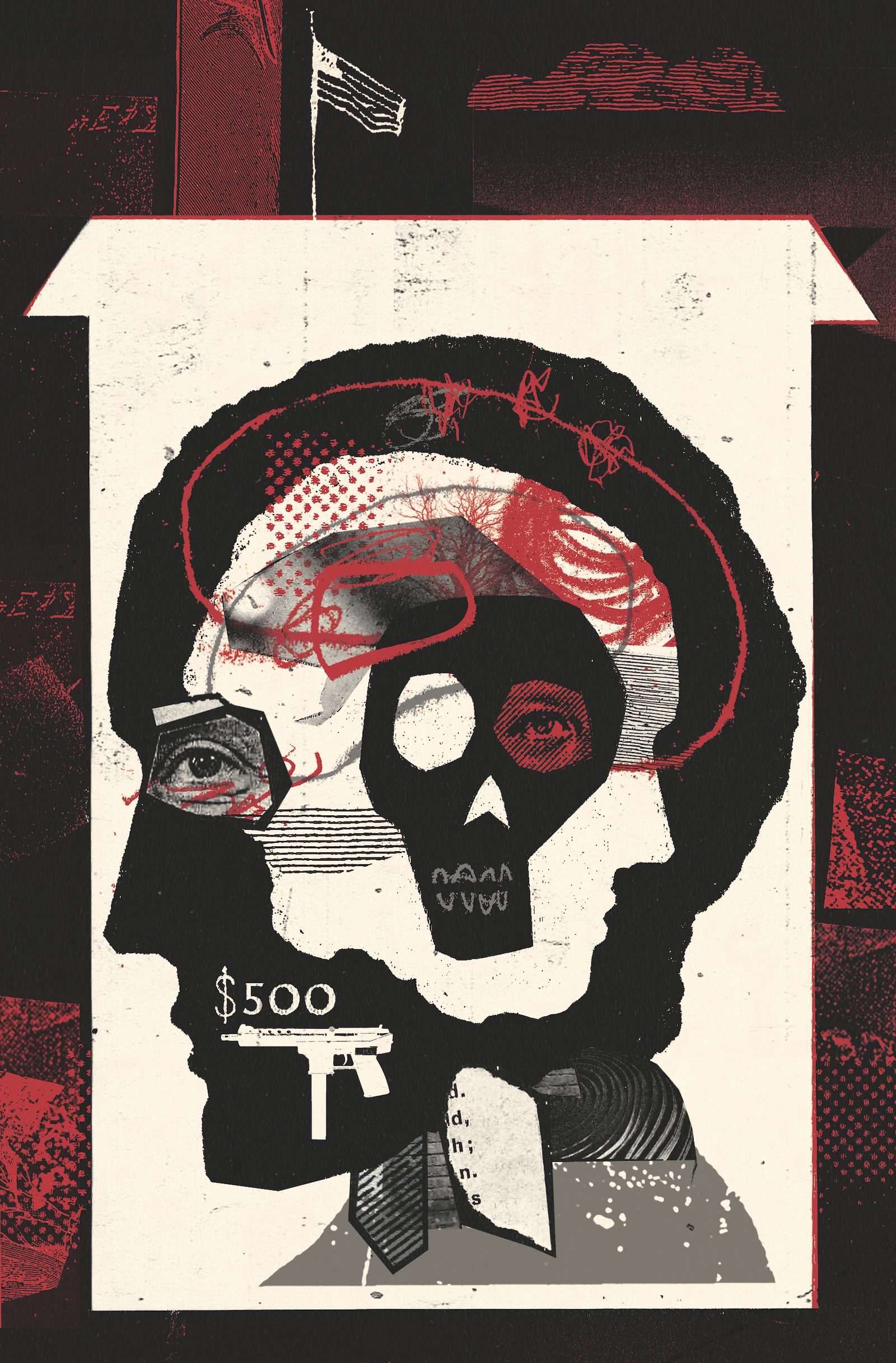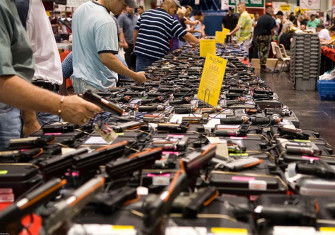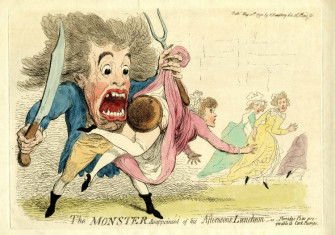Columbine 25 Years On
Columbine marked the beginning of a new era of high-profile mass shootings in the US. Was the attack the inevitable outcome of lax controls and a culture of gun glorification?

Perhaps the most important thing to know about the most infamous school shooting in US history is that it was never meant to be a school shooting. That it is remembered primarily in this way – that the word ‘Columbine’ has become a shorthand for angry young men brandishing deadly firearms – demonstrates how the myths of that day shape historical memory while obscuring historical reality.
What only became clear in the months and years after the Columbine High School massacre was that Eric Harris, 18, and Dylan Klebold, 17, had planned to execute the deadliest terrorist attack in US history in their suburban Denver high school on 19 April 1999. The plan’s centrepiece was a series of homemade bombs set to explode at lunchtime, when the school’s cafeteria would be at its most crowded. Smaller explosives scattered elsewhere throughout the building would ignite an apocalyptic conflagration. Their goal was to exceed the death toll from the 19 April 1995 Oklahoma City bombing, and originally Harris and Klebold planned to carry out what they referred to as ‘Judgment Day’ on its anniversary. But a last-minute delay in getting supplies meant the bombing would have to wait until the following day.
Instead, each of the 13 people they murdered died in a much more quotidian way, by gunfire – 13 of the nearly 11,000 firearms homicides reported in the US in 1999. The guns were part of a planned second act, in which Harris and Klebold would take up positions outside the school, shooting fleeing students. But the bombs failed to detonate so instead the killers stormed the school, searching for victims before killing themselves. The attack would be remembered as a school shooting, marking the beginning of a new era of high-profile mass killings in American schools and elsewhere, all of them enabled by the easy availability of deadly firearms. Columbine – a failed school bombing turned mass shooting – begat Virginia Tech, Sandy Hook, Parkland and Uvalde.
Easy access
School shootings in 1990s America were rare but not unheard of. In 1998, a year before Columbine, two boys aged 13 and 11 brought several firearms with them to school outside of Jonesboro, Arkansas, killing four students and a teacher. Two months later a 15-year-old boy walked into his school cafeteria in Springfield, Oregon, with a semi-automatic rifle and murdered two students; he had killed his parents at home the previous day. President Bill Clinton tasked Attorney General Janet Reno with investigating these shootings and, more generally, what appeared to be an uptick in violence in schools.
The commonality between these incidents and Columbine was teenage boys and guns. Since the end of the Second World War, American parents and politicians alike had fretted about the easy access children had to firearms in a country that venerated the gun and offered access to it like no other. Popular culture, from the television westerns of the 1950s such as The Rifleman and Have Gun – Will Travel to the gangster rap of the 1990s, glorified guns and connected them to aspirational manhood across social and economic divides. Amid a spike in crime rates in the late 1980s and early 1990s, politicians and commentators speculated endlessly about what access to guns and pop culture did to young men; most infamous was the ‘superpredator’ concept, a since-debunked theory that a generation of remorseless young killers, mostly Black and Latino, were coming of age in America’s cities. Despite a patchwork of state and federal laws meant to keep guns out of the wrong hands in a country of more than 200 million firearms, by the 1990s it had become almost impossible to keep them away from a determined teenager.
Making a murderer
Teenage boys with guns felt characteristically American but everything else about Columbine seemed novel. Harris and Klebold’s plans dwarfed anything that came before; the targets appeared to be not so much their fellow students as the viewing public, forced to suffer through the horror of seeing this seemingly safe suburban space desecrated. They left behind extensive evidence of their intentions – journals and a series of home video recordings that became known as the ‘Basement Tapes’, filmed in the weeks leading up to the attack.
Much of the story of that day, the killers’ lives leading up to it, and the survivors’ struggle thereafter is recounted in Columbine (2009) by journalist Dave Cullen. He covered the story in 1999 and spent years painstakingly reconstructing events and biographies, and attempting to correct so many of the rumours and myths that had become increasingly embedded in public memory.
In particular, Cullen wrestled with Columbine’s most challenging question: why? There were many ready explanations in the immediate aftermath of the attack: everything from guns, goth culture, violent video games and bullying to the influence of shock rocker Marilyn Manson, Nazism, religious hatred and negligent parenting. Mass media recycled scripts dating back to the 1950s about teenage boys and guns. Americans catalogued their own social pathologies and attempted to apply each of them in turn.
But Cullen eventually gathered historical evidence that almost nobody on 20 April 1999 knew existed: the killers’ own explanations for why they did what they did. Their journals and recordings laid it all out explicitly, but police officials stonewalled efforts to release these and other documents to the public. Much of this evidence was kept secret for months and even years after April 1999, allowing rumour to become intractable myth.
Relying on newly released evidence, Cullen wrote a 2004 article for Slate, ‘The Depressive and the Psychopath’, describing Klebold and Harris respectively. The journals and tapes revealed Klebold to be suicidally depressive and easily manipulated by a trusted friend to commit a horrific crime. Harris, on the other hand, appeared to so many of the investigators who looked at the case to be a textbook psychopath, someone incapable of empathy for other human beings and harbouring a god-like superiority complex. Neither was bullied; if anything, they dabbled in bullying themselves. Harris imagined himself an Übermensch – and Klebold followed along.
Cullen, in other words, asked Americans to look internally, to the mental state of the two killers, rather than externally, to the society that produced them. Without a more convincing contextual explanation – depositions of the killers’ parents are sealed until 2027 – it’s likely to remain the consensus.
‘Gun show loophole’
But what of the guns? They were the common denominator in mass murders at schools before Columbine, and the killers who have followed, many of whom would cite Harris and Klebold as inspiration, have also turned to them as effective tools for the task.
‘Bombs are hard’, Cullen noted, but guns are easy – easy to get, easy to load, easy to fire. ‘I want to torch and level everything’, Harris wrote in one journal entry, ‘but bombs of that size are hard to make.’ He and Klebold used four guns in the killings: two shotguns with barrels they sawed down to well below the legal limit, a carbine rifle and a TEC-9 semi-automatic pistol. The TEC-9 was one of the guns banned by name in the 1994 Federal Assault Weapons Ban, but one of the law’s loopholes allowed for the possession and resale of firearms that had been manufactured before the ban. When the killers’ acquaintance Mark Manes sold them the gun for $500 in the weeks before the shooting, he broke the law not because he sold a banned gun but because he sold it to minors. Manes had purchased it legally for $491 at the same gun show where Harris and Klebold would acquire their other weapons, with the assistance of an 18-year-old friend named Robyn Anderson.
After it was discovered how the killers acquired their firearms, the ‘gun show loophole’ entered the mainstream language of gun politics where it still exists today, one of a handful of perennial issues raised by a range of ‘gun safety’ organisations. The 1993 Brady Handgun Violence Prevention Act mandated background checks on all retail gun transactions through licensed dealers. But the law did not require a background check on sales between private individuals. Common estimates for such sales range as high as 40 per cent of all US gun sales annually, though some scholars have suggested this is an overestimation. Many of these sales occur outside of gun shows, but they became associated with shows because the 1986 Reagan-era Firearm Owners Protection Act loosened laws about where retailers could sell guns. The Act also allowed for licensed retailers to make private sales at gun shows without background checks under certain conditions.
Quotidian terror
Would universal background checks have stopped the killings at Columbine? Or those that followed at Virginia Tech, Sandy Hook, Parkland or Uvalde? Would red flag laws – laws that allow courts to temporarily seize someone’s firearms if they present a threat to others or themselves – have prevented the attacks from taking place? It is hard to imagine in the 21st century, in a nation of more than 400 million guns, denying committed killers the most convenient tools for the task. The Columbine killers’ bombs did not explode – in that they proved, fortunately, failures. But in making a more commonplace connection between America’s near limitless gun stockpile and its most vulnerable social spaces, they successfully ushered in an era of quotidian terror.
Andrew C. McKevitt is the author of Gun Country: Gun Capitalism, Culture and Control in Cold War America (University of North Carolina Press, 2023).






